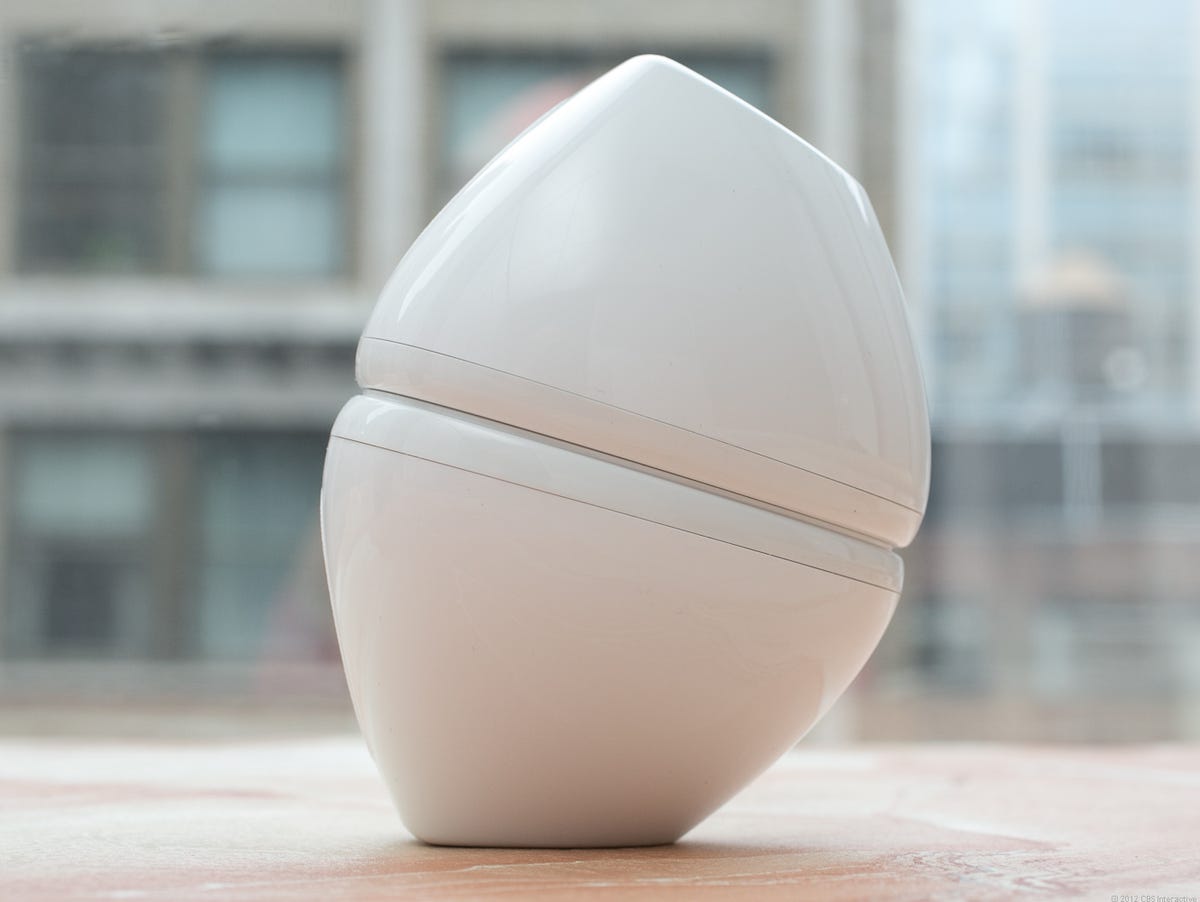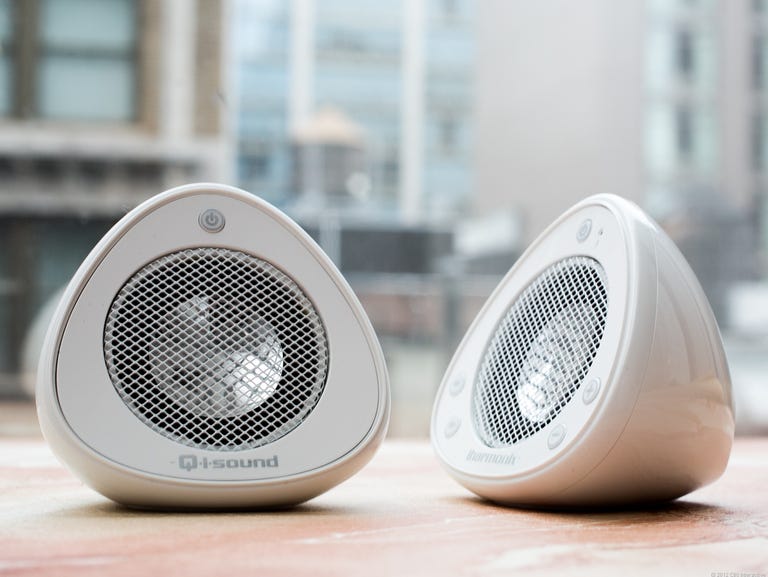 Why You Can Trust CNET
Why You Can Trust CNET iharmonix Q-i-sound review: iharmonix Q-i-sound
Bluetooth speakers are all the rage, and the Qmadix Iharmonix Q-i-sound takes the concept one step further with real cordless stereo skills.
Though most cell phone stereo docks have made the transition over to Bluetooth wireless technology, the majority of these devices wrap up everything in a single unit. Sure, that design makes them portable, but you're out of luck if you're yearning to place your speakers at varying distances or even at slightly different heights. Fortunately, the $149.99 Qmadix Iharmonix Q-i-sound, which uses two completely wireless speakers to produce real stereo two-channel audio, may be your ticket to freedom.
The Good
The Bad
The Bottom Line
Design
The Qmadix Iharmonix Q-i-sound certainly looks like no other Bluetooth speaker system I’ve ever seen. Small and pod-shaped, the white model I reviewed reminds me of a pair of robotic eggs, or perhaps one egg split into two halves. If a traditional look is more your speed, the product comes in black as well.
What really sets the Q-i-sound apart from other Bluetooth speaker systems, however, is that it's capable of providing true two-channel stereo audio without wires. That means you can position each satellite wherever you like, on multilevel shelves, by the bathroom shower, or on different tables. It's a feature that creates plenty of flexibility to accommodate challenging listening environments.
The device has the typical controls you'd expect to see on a Bluetooth audio product. The face of the left speaker unit houses buttons for power, volume, and track forward and back. Also here is a tiny microphone for conducting calls when the device is linked to a mobile phone. The back of each speaker pod holds only one port, a small proprietary jack for attaching the Q-i-sound's AC charger. Unfortunately, without any other ports, you won't be able to hook up older audio gadgets via a wired connection.

There's no doubt that the Q-i-sound is meant to see lots of travel. Each speaker unit weighs a quarter of a pound (0.24 pound, to be exact). They come with a handy carrying case into which the speakers fit snugly. One feature I especially like is that the rims of both speakers are magnetized and will seek to snap together for storage. This helps them stay put in their case.
Qmadix clearly took the effort to design portability into the heart of the Q-i-sound. That's why I'm mystified by its power adapter's unwieldy size. Worse, the bulky AC adapter and dual-ended cord can't fit into the speakers' nifty travel case. Another oversight is that the charger uses proprietary tips to attach to both speakers, so if you misplace the cord you'll be in a tight spot. By contrast, the Jawbone Jambox relies on a standard Micro-USB port to power up.
Performance
Setting up the Q-i-sound is a simple and relatively painless procedure. First, I fully charged both speaker units, a process that took about 3.5 hours. Then I pressed and held the left speaker's power button to kick the device into pairing mode. The Q-i-sound alerts you that it's ready to pair when all buttons on its left speaker glow a solid bluish-white. I think the quirky cooing sounds, vibration feedback, and voice alerts served up by the Jawbone Jambox, though, are more endearing.
I then connected my test HTC One S (T-Mobile) Android smartphone to the Q-i-sound by searching for the speaker system within the handset's Bluetooth settings. The last step is to press the right speaker's power button and it will then pair with the Q-i-sound's left unit automatically.
I subjected the Q-i-sound to my standard battery of music that includes everything from electronic, rock, rap, and jazz to orchestral. I found that audio from the speakers was surprisingly loud, especially considering the satellites' small size. Audiophiles won't be impressed by the Q-i-sound's performance, though. Bass was virtually absent, while audio was too bright and even splashy, tending to distort in the high end at high volume. Sound from the Jawbone Jambox, by contrast, was much richer with better presence provided by a bigger helping of bass.
I was amazed, though, that the Q-i-sound indeed produced true wireless stereo audio. I distinctly heard stereo separation on all my sample music, and the effects were heightened when playing tracks with heavy stereo tricks such as old Beatles and Esquivel albums. It was also fun to position the left and right speakers at different distances from each other to create a very wide sound stage. That's something the Jambox, or most ordinary wireless speakers, can't do, since their fixed drivers are placed so close together.
For making calls, the Q-i-sound was on par with other microphone-equipped speakers I've used, including the Jambox. People definitely knew I was speaking through some sort of speakerphone and reported that my voice sounded muffled and distant unless I was within a few inches of the mic.
Qmadix claims the Q-i-sound offers 8 hours of continuous playback and 10 days of standby time. This seems to match my experience with the device, since I'm still going strong a week after my initial charge. Of course, my usage wasn't heavy; I played music for an hour or so each day while testing.
Conclusion
I certainly give the $149.99 Qmadix Iharmonix Q-i-sound a lot of respect for creating a truly cordless stereo audio solution. Its steep price, however, is hard to swallow, especially considering the device's unsatisfying audio performance. At the moment I'd recommend splurging on the Jawbone Jambox instead, which has dropped markedly in price, down to $149.99 on Amazon, in fact, thanks to the debut of the Big Jambox. The Jambox has better features, better sound, and attractive looks. Of course, if you absolutely must have a superflexible wireless stereo audio solution, the Q-i-sound could just be what the Bluetooth doctor ordered.


